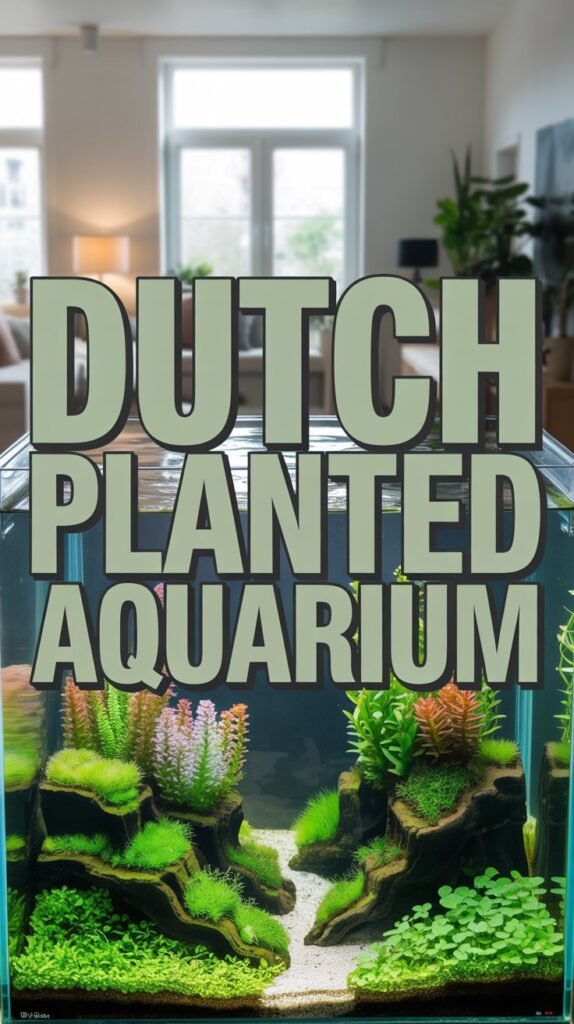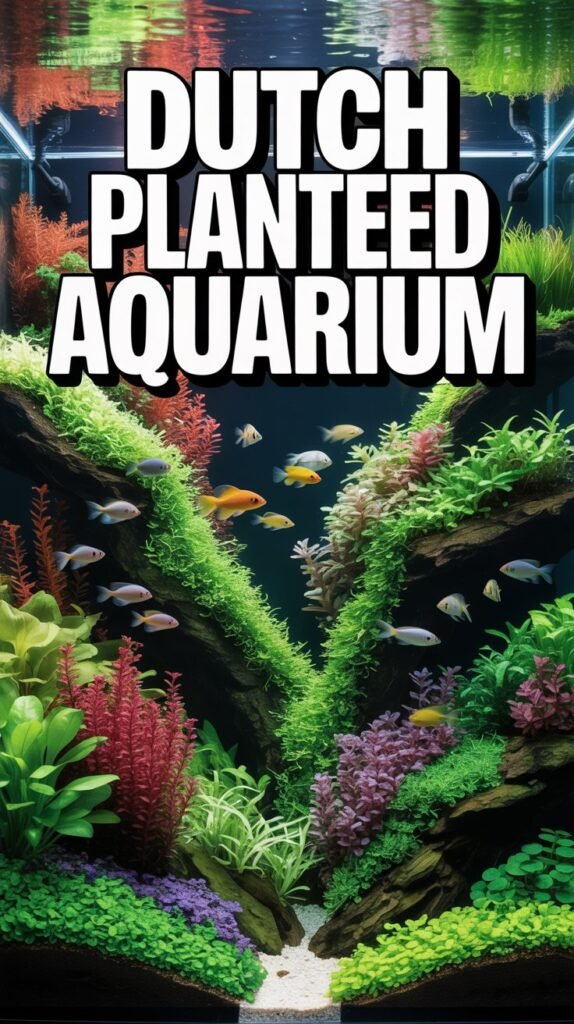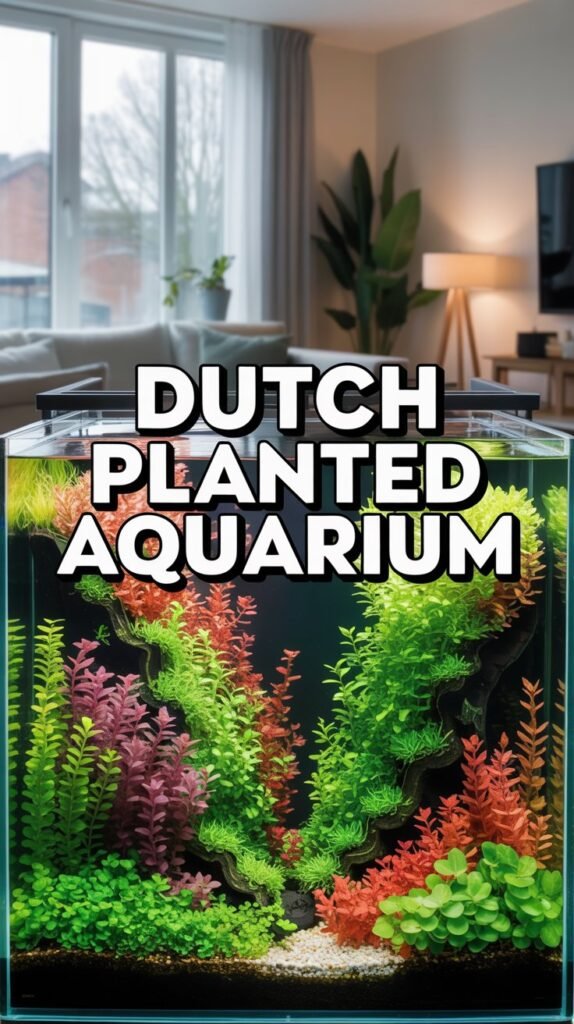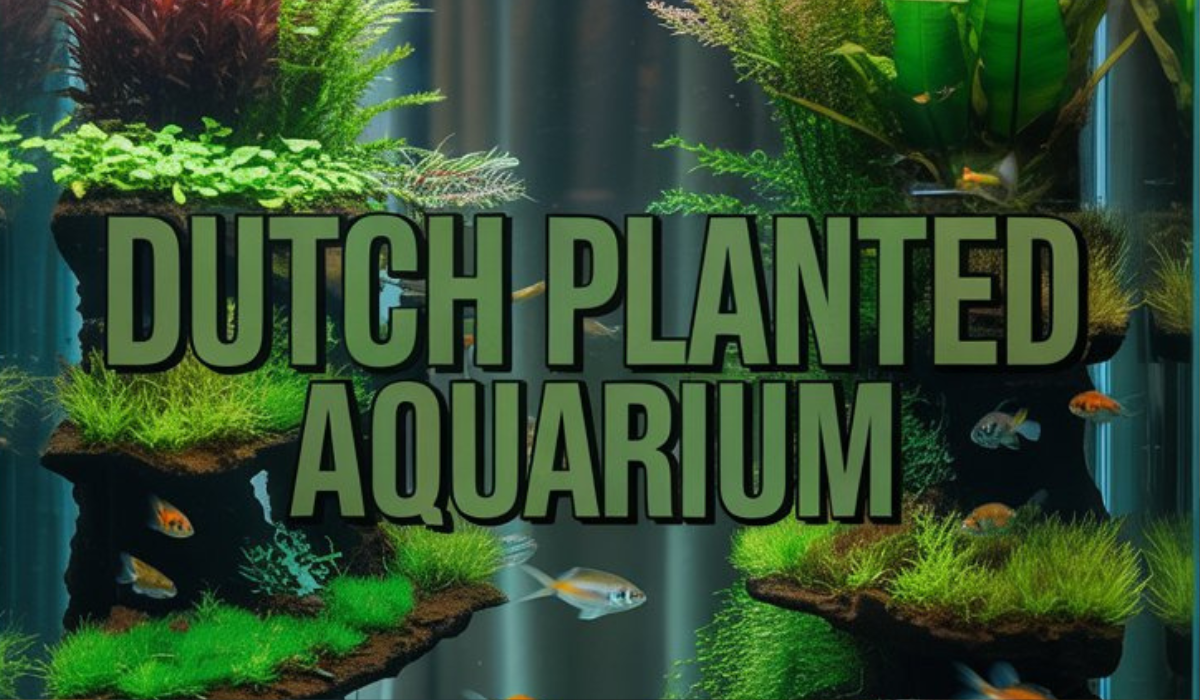If you’ve ever admired an aquarium overflowing with vibrant plants, vivid colors, and stunning design harmony, you were likely looking at a Dutch planted aquarium. Originating from the Netherlands, this aquascaping style is one of the oldest and most artistic ways to design an aquarium.
Unlike other aquascaping methods that highlight hardscape elements like rocks or driftwood, the Dutch aquarium style celebrates plants as the true stars of the tank — transforming aquariums into lush underwater gardens that resemble botanical landscapes.
In this complete guide, we’ll explore everything you need to know about the Dutch planted aquarium, including its history, setup process, essential equipment, best plant species, maintenance tips, and expert design principles that make it one of the most visually stunning styles in the aquascaping world.
What Is a Dutch Planted Aquarium?
The Dutch planted aquarium is a style of aquascaping that focuses entirely on aquatic plants, arranged in structured layers and vibrant color contrasts to create an underwater garden.
It emerged in the 1930s in the Netherlands, when aquarists started designing tanks based on terrestrial gardening principles — emphasizing plant arrangement, texture, height, and color.

Unlike other styles like the Nature Aquarium (pioneered by Takashi Amano), which mimics natural landscapes, the Dutch style is man-made, organized, and symmetrical, resembling a well-maintained botanical garden rather than a slice of nature.
Features of a Dutch Planted Aquarium
The Dutch aquarium is defined by certain distinct features that set it apart from other aquascaping styles:
- Plant-Dominated Layout – Plants are the primary focus; rocks and driftwood are minimal or absent.
- Terraced Arrangement – Plants are arranged in tiers, from shortest at the front to tallest at the back, creating depth and layering.
- Color and Texture Contrast – Different leaf shapes, colors, and sizes are used to enhance visual interest.
- Street Effect – Rows or “streets” of plants lead the viewer’s eye into the background, adding perspective and depth.
- Symmetry and Order – The tank follows balance and structure rather than randomness.
- Minimal Hardscape – Only a few stones or roots are used, if any, for accent or structure.
- Vibrant Plant Variety – A typical Dutch aquarium may contain 10–20 different plant species.
- Focal Points – Often a single group of red or large-leaved plants serves as a central visual anchor.
The goal is to create a living piece of art, a garden that thrives underwater through deliberate design and expert plant care.
The History of the Dutch Aquarium Style
The Dutch planted aquarium style originated in the early 1930s, thanks to pioneering aquarists and the formation of the Nederlandse Bond Aqua Terra (NBAT) — the Dutch Aquarium Society.
This organization developed a set of strict rules and guidelines for aquascaping competitions that emphasized plant health, composition, and color balance. The NBAT still holds contests today, and the Dutch style continues to evolve while retaining its traditional aesthetic.
This aquascaping philosophy influenced many modern designs and remains a benchmark of precision and artistry in the aquarium hobby.
Dutch Aquarium vs Nature Aquarium
Many beginners confuse the Dutch style with the Nature Aquarium style, but they’re quite different in philosophy and execution.
| Feature | Dutch Aquarium | Nature Aquarium (Amano Style) |
|---|---|---|
| Focus | Aquatic plants only | Natural landscapes (mountains, forests, rivers) |
| Hardscape | Minimal or none | Rocks and driftwood are central |
| Design Principle | Garden-like order and symmetry | Natural asymmetry and flow |
| Color & Texture | Strong contrast between plants | Subtle harmony and realism |
| Fish Role | Decorative accent | Part of the ecosystem balance |
In short, the Dutch style is structured and vibrant, while the Nature style is organic and naturalistic.
Benefits of a Dutch Planted Aquarium

- Aesthetic Appeal – A lush, colorful underwater garden that adds beauty to any space.
- Excellent Water Quality – Dense plant growth absorbs nitrates, ammonia, and CO₂, keeping water clean.
- Fish Health – Plants provide oxygen, hiding places, and natural stress relief for fish.
- Biological Stability – A heavily planted system maintains ecological balance more easily.
- Creative Expression – Offers unlimited opportunities for artistic design and color coordination.
How to Set Up a Dutch Planted Aquarium
Creating a successful Dutch aquarium takes planning, patience, and precision. Let’s break down the process step by step.
Step 1: Choose the Right Aquarium Size
While Dutch aquariums can be of any size, medium to large tanks (40–75 gallons or 150–300 liters) provide more space for plant variety and layering.
Recommended dimensions:
- Minimum length: 36 inches (90 cm)
- Height: 18–24 inches
- Depth: 18–20 inches
This allows you to build distinct plant groups and create proper depth perspective.
Step 2: Select the Right Equipment
A successful Dutch planted tank depends on providing the right lighting, CO₂, and filtration systems.
Lighting
- Plants in Dutch aquariums need strong light for healthy growth and color development.
- Use high-quality LED lights with a spectrum of 6500K–7000K.
- Maintain 8–10 hours of light per day using a timer for consistency.
CO₂ Injection
- CO₂ is crucial for dense plant growth and vibrant coloration.
- Maintain 20–30 ppm of CO₂ in the water column.
- Use a CO₂ diffuser or reactor for even distribution.
Filtration
- Use a canister filter to maintain water clarity and circulate nutrients.
- Opt for models that allow easy customization with biological and mechanical media.
Heater
- Most aquatic plants thrive between 72–82°F (22–28°C).
- Use a reliable heater with a built-in thermostat to maintain consistent temperature.
Step 3: Substrate Selection
The substrate is the foundation of any planted tank, especially in a Dutch aquarium where plant health is paramount.
Ideal substrate types:
- Nutrient-rich planted substrates (ADA Aqua Soil, Fluval Stratum, Tropica Soil)
- Layered system: Use a nutrient base layer topped with fine gravel or sand for better plant rooting and visual appeal.
Tip: Avoid bright-colored gravel; natural tones enhance plant colors and contrast better.
Step 4: Fertilization and Nutrient Balance
Since Dutch aquariums have many fast-growing plants, consistent fertilization is essential.
Fertilization essentials:
- Macronutrients: Nitrogen (N), Phosphorus (P), Potassium (K)
- Micronutrients: Iron (Fe), Manganese (Mn), Zinc (Zn)
- Liquid fertilizers: Add weekly or daily as per plant needs.
- Root tabs: Use for heavy root feeders like Cryptocorynes and Echinodorus.
Pro Tip: Use the EI (Estimative Index) or Tropica nutrient system to maintain balance and prevent deficiencies.
Step 5: Layout and Planting Design

Design is where the Dutch aquarium truly shines. Follow these guidelines to create a classic Dutch layout.
1. Layered Terraces
- Arrange plants in foreground, midground, and background.
- Each layer should have distinct color and texture.
2. Contrast and Color Harmony
- Alternate red and green plants or broad and fine-leaved species.
- Limit red plants to one or two groups to avoid visual chaos.
🪻 3. The Street Effect
- Create “streets” or rows of plants leading to the background center.
- Each street should use one species only.
- Leave space (around 3–4 cm) between rows for clarity.
4. Symmetry and Balance
- Keep both sides balanced but not identical.
- Place a bold red or tall green plant as a focal point off-center.
5. Background Variety
- Use tall stem plants like Hygrophila, Ludwigia, or Rotala species for height and texture.
Step 6: Plant Selection
The beauty of a Dutch aquarium depends on plant diversity. Here are ideal choices for each section:
Foreground Plants
- Staurogyne repens
- Cryptocoryne parva
- Echinodorus tenellus
- Lilaeopsis brasiliensis
Midground Plants
- Alternanthera reineckii
- Ludwigia repens
- Bacopa caroliniana
- Hygrophila corymbosa
- Microsorum pteropus (Java fern)
Background Plants
- Rotala rotundifolia
- Limnophila sessiliflora
- Cabomba caroliniana
- Hygrophila polysperma
- Echinodorus bleheri
Tip: Choose at least 10–12 species with different leaf shapes, colors, and growth habits for a true Dutch look.
Step 7: Adding Fish and Invertebrates
Fish add motion and contrast but should not distract from the plant layout.
Ideal fish species:
- Neon Tetras
- Cardinal Tetras
- Rummy Nose Tetras
- Harlequin Rasboras
- Dwarf Gouramis
- Cherry Barbs
Invertebrates:
- Amano Shrimp
- Nerite Snails
- Otocinclus Catfish
Keep fish populations light to avoid disturbing plants or overcrowding the design.
Maintenance of a Dutch Planted Aquarium
Dutch aquariums require regular care and trimming to retain their shape and vibrancy.
Weekly Tasks
- 30–50% water change
- Prune overgrown plants
- Clean glass and remove algae
- Check CO₂ levels and pH
- Dose fertilizers
Monthly Tasks
- Replant or rearrange trimmed stems
- Replace aging plants
- Deep clean filter media
- Inspect lighting and CO₂ systems
Pruning Tips:
- Trim fast growers weekly to maintain tiered structure.
- Replant trimmed tops to encourage bushier growth.Common Problems and Solutions
| Problem | Cause | Solution |
|---|---|---|
| Algae growth | Excess nutrients or light imbalance | Reduce lighting to 8 hours; add algae eaters |
| Pale leaves | Nutrient deficiency (iron or nitrogen) | Add fertilizers or root tabs |
| Poor plant growth | Low CO₂ or lighting | Increase CO₂ or upgrade lighting |
| Fish gasping | Excess CO₂ | Reduce injection rate or increase aeration |
| Overcrowded layout | Lack of trimming | Regular pruning to maintain definition |
Example Layout Plan
A classic 4-foot (120 cm) Dutch aquarium layout could be:
- Front left: Cryptocoryne wendtii
- Mid left: Alternanthera reineckii
- Center background: Ludwigia arcuata (red focal point)
- Right midground: Hygrophila difformis
- Foreground: Staurogyne repens and Lilaeopsis brasiliensis
- Background corners: Rotala rotundifolia and Limnophila aquatica
This combination ensures a balanced, colorful, and layered visual effect.
The Role of Fish in a Dutch Aquarium
In Dutch aquascapes, fish are secondary but still important. They:
- Add movement and life
- Provide contrast against greenery
- Produce nutrients (fish waste) beneficial for plants
Avoid large or aggressive species that might uproot plants. Small schooling fish enhance the peaceful garden ambiance perfectly.
Tips for a Successful Dutch Planted Aquarium
- Start Slow: Begin with easy plant species before adding high-maintenance reds.
- Consistency is Key: Maintain regular trimming and dosing schedules.
- Avoid Overcrowding: Each plant group should be distinct and clearly separated.
- CO₂ and Light Balance: Don’t increase one without adjusting the other.
- Observe Daily: Watch plant and fish behavior to catch problems early.
- Enter Competitions: Join local or online Dutch aquascaping contests for feedback and inspiration.
Conclusion
A Dutch planted aquarium is more than just a fish tank — it’s an underwater garden masterpiece that showcases the beauty of aquatic plants through structure, balance, and color harmony.
Unlike natural styles that mimic wilderness, the Dutch approach reflects human artistry and discipline. It combines science and aesthetics, demanding both technical skill and creative vision.
If you’re passionate about aquascaping, diving into the Dutch style is a rewarding challenge. With the right lighting, CO₂, plant care, and patience, you can create an aquarium that looks like a living painting — lush, colorful, and endlessly captivating.
FAQs About Dutch Planted Aquariums
Q1. What makes a Dutch planted aquarium unique?
A Dutch aquarium focuses entirely on plants, using structured layers, color contrasts, and symmetry rather than rocks or wood.
Q2. How many plant species should I use?
Use 10–20 species with varied shapes and colors to create a balanced composition.
Q3. Do I need CO₂ injection for a Dutch aquarium?
Yes, CO₂ is essential for dense, healthy plant growth and vibrant colors.
Q4. Can beginners create a Dutch-style aquarium?
Yes, but start with easy plants and small layouts before attempting full competition-level designs.
Q5. How often should I trim the plants?
Trim weekly or biweekly to maintain shape and prevent overcrowding.
Q6. What lighting do I need?
High-intensity LED lighting (6500–7000K) for 8–10 hours daily is ideal.
Q7. Are Dutch aquariums suitable for all fish?
They’re best for small, peaceful species like tetras, rasboras, and shrimp.
Q8. Can I add rocks or wood?
Yes, but sparingly. The focus should remain on plants.
Q9. What’s the ideal tank size for a Dutch aquarium?
A 40–75 gallon tank is ideal for maintaining plant diversity and depth.
Q10. How long does it take to establish a Dutch aquarium?
Expect 8–12 weeks for plants to root, fill out, and achieve the desired aesthetic balance.

